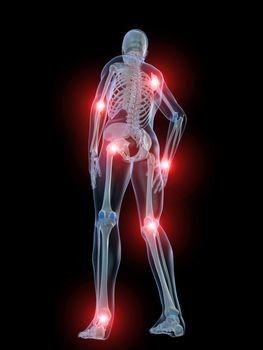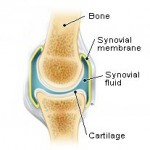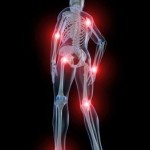The connecting places of two or more bones in our body are called joints, when these joints start to pain, it is called aching
joints. The joints in our body can be affected by any kind of ache. It may result from old or recent injuries, strains or sprains. Many kinds of illnesses are known to cause aching joints. Everything from simple cold to Arthritis are known to cause aching joints as well as many bacterial infections. At times intake of certain medicines may cause your joints to ache. Some of these causes could be serious while some other could be minor passing causes. Some of the common causes of aching joints are infections, arthritis,
Lyme disease, tendinitis, & bursitis.
At risk groups
- Family history of rheumatoid arthritis
- Genetic component also suggested for OA – twins studies show 50% concordance in women
with OA in hands. - Occupational history of prolonged, repetitive use of hands
- Manual labour
- Overweight
- Previous history of trauma in the joint
Causes of Aching Joints
Let us now briefly discuss how these causes aching joints in your body.
- Infections:
Many types of viral & bacterial infections may cause aching joints. These viral infections may range from common cold to more serious type of flues. That is why when you have a runny nose, headache, cough or congestion, you also get aching joints. These infections are communicable through touch or by transfer of infection. These types of problems are also minor in nature & can be
treated easily.
- Arthritis:
Arthritis happens when there is inflammation in joints. Due to these inflammations the joints start to ache. Arthritis causes a lot of pain & stiffness in the joints. It can occur on any joints in our body, but it more commonly occurs on joints which are much tenderer compared to the others.
- Bursitis:
 Bursitis is a condition that causes swelling & pain around the muscles & bones. A Bursa is a fluid filled sac that offers a bit of cushioning effect between the muscles & the bones. When this Bursa swells, it causes the joints to ache. The most common location where the joints can ache because of bursitis is elbow, hip, shoulder, ankle & knee. The conditions which are typically responsible for causing bursitis in the joints may include rheumatoid arthritis, gout or any kind of trauma.
Bursitis is a condition that causes swelling & pain around the muscles & bones. A Bursa is a fluid filled sac that offers a bit of cushioning effect between the muscles & the bones. When this Bursa swells, it causes the joints to ache. The most common location where the joints can ache because of bursitis is elbow, hip, shoulder, ankle & knee. The conditions which are typically responsible for causing bursitis in the joints may include rheumatoid arthritis, gout or any kind of trauma.
- Lyme disease:
Lyme disease happens due to bacterial infection. It also causes inflammation of joints resulting in extreme pain & stiffness. It occurs due to tick bites infected with the Borrelia burgdorferi bacterium. This type of ache joint infection normally happens in the time between late spring & early fall. The Lyme disease can become serious if it is left untreated. The symptoms of Lyme disease are skin rash, pain in the joints, flu like fever, nausea, runny nose & headache with a lot of chills. The initial sign of a Lyme disease is a Bull’s Eye rash with a inflamed red spot in the middle.
- Tendinitis:
A fibrous structure called tendon connects the muscles with the bones. When this tendon gets inflammated, it causes a lot of pain in the joints. Tendinitis may happen due to constant use of a particular joint, ageing of a person or if there is mental trauma. The symptoms of Tendinitis are pain in the joints, Aching Joints or a feeling of warmth in the joint that is affected.
Diagnosis involves interviewing the patient and performing physical exams. When attempting to establish the cause of the arthralgia, the emphasis is on the interview. The patient is asked questions intended to narrow the number of potential causes. Given the varied nature of these possible causes, some questions may seem irrelevant. For example, the patient may be asked about dry mouth, light sensitivity, rashes or a history of seizures. Answering yes or no to any of these questions limits the number of possible causes and guides the doctor toward the appropriate exams and lab tests.
Treatment
Treatment depends on a specific underlying cause. The underlying cause will be treated first and foremost. The treatments may include joint replacement surgery, for severely damaged joints, immunosuppressants for immune system dysfunction, antibiotics when an infection is the cause, and discontinuing medication when an allergic reaction is the cause. Conservative chiropractic care has also shown to be beneficial in the relief of symptoms. When treating the primary cause, pain management may still play a role in treatment. The extent of its role varies depending on the specific cause of the arthralgia. Pain management may include stretching exercises, over the counter pain medications, prescription pain medication, or other treatments deemed appropriate for the symptoms.


